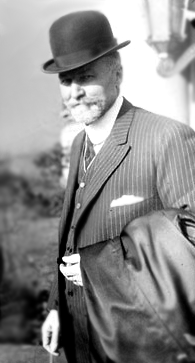John Benjamin Murphy | |
|---|---|
 Murphy outside of Mercy Hospital after Theodore Roosevelt's assassination attempt in 1912 | |
| Born | December 21, 1857 |
| Died | August 11, 1916 (aged 58) |
| Resting place | Calvary Cemetery |
| Alma mater | Rush Medical College, 1879 |
| Known for | President, American Medical Association artificial pneumothorax appendectomy |
| Awards | Order of St. Gregory the Great |
| Scientific career | |
| Institutions | Mercy hospital, Chief of Staff Rush Medical College College of Physicians and Surgeons Northwestern University Medical School Cook County Hospital Graduate Medical School of Chicago |
| Signature | |
John Benjamin Murphy, born John Murphy[1] (December 21, 1857 – August 11, 1916) was an American physician and abdominal surgeon noted for advocating early surgical intervention in appendicitis appendectomy, and several eponyms: Murphy’s button,[2] Murphy drip,[2][3] Murphy’s punch, Murphy’s test, and Murphy-Lane bone skid. He is best remembered for the eponymous clinical sign that is used in evaluating patients with acute cholecystitis.[4] His career spanned general surgery, orthopedics, neurosurgery, and cardiothoracic surgery, which helped him to gain international prominence in the surgical profession.[4] Mayo Clinic co-founder William James Mayo called him "the surgical genius of our generation".[4]
Over the course of his career he was renowned as a surgeon, a clinician, a teacher, an innovator, and an author. In addition to general surgical operations, such as appendectomy, cholecystostomy, bowel resection for intestinal obstruction, and mastectomy, he performed and described innovative procedures in neurosurgery, orthopedics, gynecology, urology, plastic surgery, thoracic surgery, and vascular surgery. He also ventured into techniques such as neurorrhaphy, arthroplasty, prostatectomy, nephrectomy, hysterectomy, bone grafting, and thoracoplasty.[1]
- ^ a b Morgenstern, Leon (March 2006). "John Benjamin Murphy (1857-1916): An American Surgical Phenomenon" (PDF). Surgical Innovation. 13 (1). Sage Publications: 1–3. doi:10.1177/155335060601300101. PMID 16708149. S2CID 5097576. Retrieved May 14, 2008.[permanent dead link]
- ^ a b Griffith, B.; Yao, J.(2000) Journal of the American College of Surgeons A Centennial History of the Chicago Surgical Society. Volume 191, Issue 4, Pages 419 - 434.
- ^ Journal of the American Medical Association (April 17, 1909) Proctoclysys in the Treatment of Peritonitis (the Murphy Drip).
- ^ a b c Cite error: The named reference
JBM11was invoked but never defined (see the help page).